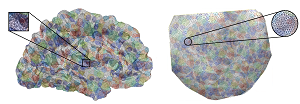Predicting Future Cognitive Decline with Hyperbolic Stochastic Coding
Jie Zhang, Qunxi Dong, Jie Shi, Qingyang Li, Cynthia M. Stonnington, Boris A. Gutman, Kewei Chen, Eric M. Reiman, Richard J. Caselli, Paul M. Thompson, Jieping Ye, Yalin Wang, and for the Alzheimer’s Disease Neuroimaging Initiative
Abstract
Hyperbolic geometry has been successfully applied in modeling brain cortical and subcortical surfaces with general topological structures. However, such approaches, similar to other surface-based brain morphology analysis methods, usually generate high dimensional features. It limits their statistical power in cognitive decline prediction research, especially in datasets with limited subject numbers. To address the above limitation, we propose a novel framework termed as hyperbolic stochastic coding (HSC). We first compute diffeomorphic maps between general topological surfaces by mapping them to a canonical hyperbolic parameter space with consistent boundary conditions and extracts critical shape features. Secondly, in the hyperbolic parameter space, we introduce a farthest point sampling with breadth-first search method to obtain ring-shaped patches. Thirdly, stochastic coordinate coding and max-pooling algorithms are adopted for feature dimension reduction. We further validate the proposed system by comparing its classification accuracy with some other methods on two brain imaging datasets for Alzheimer’s disease (AD) progression studies. Our preliminary experimental results show that our algorithm achieves superior results on various classification tasks. Our work may enrich surface-based brain imaging research tools and potentially result in a diagnostic and prognostic indicator to be useful in individualized treatment strategies.





